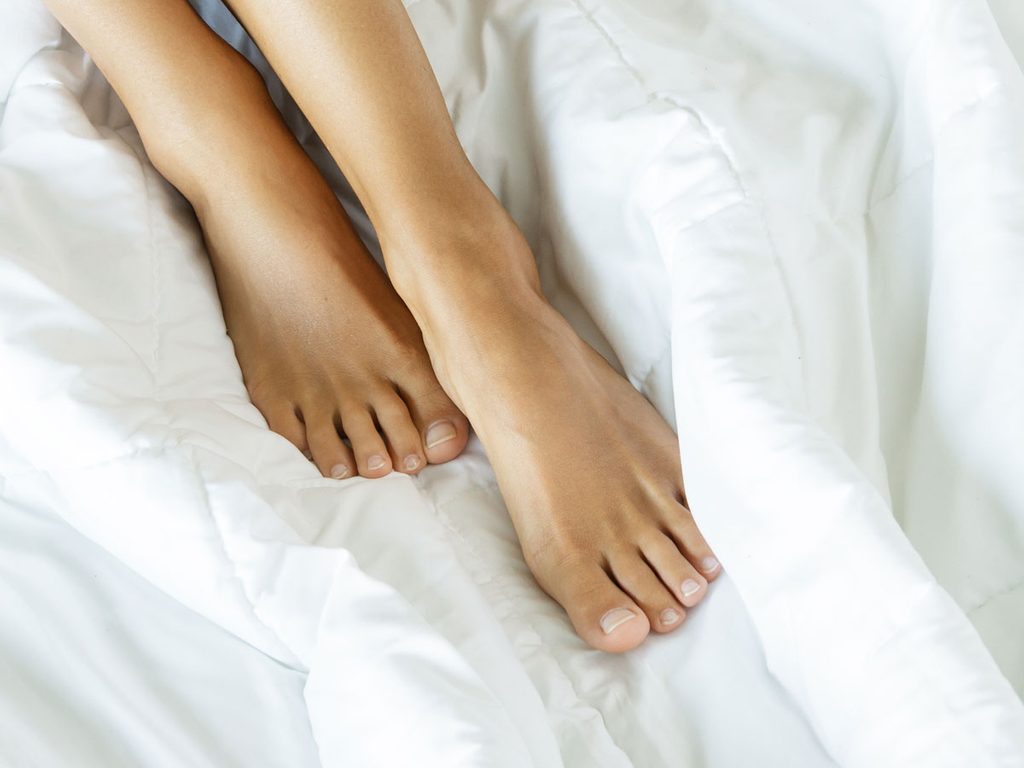What Are Diabetic Blisters? Here’s What You Need to Know

Diabetic blisters are a common skin condition when you have diabetes.
It’s important to take care of your feet when you have diabetes. Roughly 80 percent of people with diabetes will experience some sort of skin disorder as a result of the disease, according to a 2014 analysis in the American Journal of Clinical Dermatology. One such condition is the development of diabetic blisters.
Here’s everything you need to know to identify, treat, and avoid them.
What are diabetic blisters?
“A diabetic blister, also known as bullosis diabeticorum or diabetic bullae, is a fluid-filled pocket formed in the upper layer of the skin,” explains board-certified podiatric surgeon Miguel Cunha, founder of Gotham Footcare in New York City. “It looks similar to a blister caused by a burn, but without the related pain.” The fluid inside the blister is clear and typically harmless, adds Cunha, but can lead to bleeding or turn to pus if the blister becomes infected.
Most commonly found on the toes, feet, and legs, diabetic blisters also occasionally form on the fingers, hands, and forearms. They range widely in size, but are generally painless and won’t have any redness in the surrounding areas.
Who gets them
“Diabetic blisters are rare and occur twice as often in men as in women,” says Cunha, who explains, “0.5 percent of diabetic patients in the U.S. population (about 171,000 people) will develop them.” According to a study in Clinical Diabetes, diabetics with longstanding peripheral neuropathy, or damage to the nerves that extend into the extremities, are most likely to get blisters.
Causes of diabetic blisters
“It is not very clear why diabetic blisters occur. In fact, many appear without any known injury,” Cunha says. One known cause, however, is ill-fitting shoes. “The constant friction of skin on the material of a shoe that does not fit well over long periods of time can result in a blister,” he explains. “And if foot moisture is also present in conjunction with the rubbing, this can exacerbate the formation of one.”
Poorly controlled blood sugar levels can also prime the body for the formation of blisters. “Diabetics can lose sensation in the lower extremities due to poor circulation or neuropathy,” says Cunha, which may lead to the development of a blister that goes unnoticed and grows unchecked. High blood sugar can even cause diabetics to develop fungal infections like Candida albicans, he adds, which can cause a red, itchy rash along with the blisters and make further complications more likely.
(Related: 10 Subtle Signs of Disease Your Feet Can Reveal)
Treatment for diabetic blisters
“Diabetic blisters generally heal on their own within a few weeks,” says Cunha. The key is to leave them alone and allow the body to do the work for you. “To avoid infection and speed up recovery, you shouldn’t poke, pop, or peel the blister,” Cunha says. “Instead, keep it clean with soap and water and change your socks a few times a day. Keeping your blood sugar levels controlled will also speed the healing process.”
Also smart: Wearing shoes throughout the life of the blister that don’t directly rub on the area. “The main concern is to prevent blisters from becoming infections,” says podiatric surgeon Rebecca Pruthi, DPM, owner of Foot Care of Manhattan in New York City. “If they get infected, they can be aspirated in a doctor’s office and treated with topical antibiotics.” If the blister does pop or treatment with an antibacterial cream or ointment is needed, you can use a bandage to prevent further rubbing. “If there is itchiness, swelling, redness, warmth, or pain around the blister or you have a fever, you should contact your podiatrist immediately,” Cunha says.
(Related: Home Remedies to Quickly Heal Blisters)
How to prevent diabetic blisters
“Diabetics need to take extra care of their feet,” says Cunha. “Those with neuropathy or circulation issues might not notice or feel the blisters and lesions, so it’s important to inspect the feet daily.” Making sure your shoes aren’t too tight and aren’t rubbing on one part of the foot more than others is critical. One trick to avoid this: “Buy shoes at the end of the day when your feet are most swollen,” suggests Cunha. “This will stop you from buying shoes that will fit too tightly throughout the day. Then if you need to break them in, wear them in hour-long increments until they feel comfortable.” Always wearing socks with shoes will also reduce the friction that can lead to a blister.
“Since blisters occur in patients with poorly managed blood sugar, it’s very important that preventative measures be taken to keep blood sugar under control,” adds Pruthi. That means taking steps in the kitchen to maintain steady blood sugar and knowing the sneaky lifestyle habits that can cause your blood sugar to spike.
With proper vigilance and diabetes control, diabetic blisters are possible to prevent and simple to heal. But if you notice something more than a blister, such as a foot ulcer, further medical help may be needed.
Next: Telehealth Services Available to Canadians During the Pandemic




